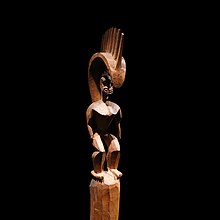This article needs additional citations for verification. (February 2008) |
| Lono | |
|---|---|
fertility, agriculture, rainfall, music and peace. | |
 Late 18th-century figure of Lono, on display at the Louvre. | |
| Gender | male |
| Genealogy | |
| Born | near the graves of Keawe |
In Hawaiian religion, the god Lono is associated with fertility, agriculture, rainfall, music and peace. In one of the many Hawaiian stories of Lono, he is a fertility and music god who descended to Earth on a rainbow to marry Laka. In agricultural and planting traditions, Lono was identified with rain and food plants. He was one of the four gods (with Kū, Kāne, and Kāne's twin brother Kanaloa)[1] who existed before the world was created. Lono was also the god of peace. In his honor, the great annual festival of the Makahiki was held. During this period (from October through February), war and unnecessary work was kapu (forbidden).
In Hawaiian weather terminology, the winter Kona storms that bring rain to leeward areas are associated with Lono. Lono brings on the rains and dispenses fertility, and as such was sometimes referred to as Lono-makua (Lono the Provider). Ceremonies went through a monthly and yearly cycle. For 8 months of the year, the luakini (temple) was dedicated to Ku-with strict kapus. Four periods (kapu pule) each month required strict ceremonies. Violators could have their property seized by priests or overlord chiefs, or be sentenced to death for serious breaches.[2]